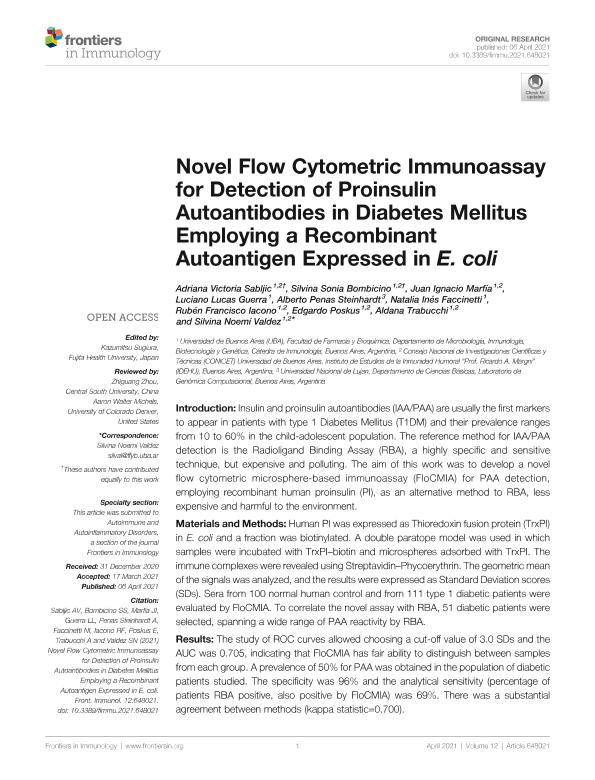Artículo
Novel flow cytometric immunoassay for detection of proinsulin autoantibodies in diabetes mellitus employing a recombinant autoantigen expressed in E. coli
Sabljic, Adriana Victoria; Bombicino, Silvina Sonia ; Marfía, Juan Ignacio
; Marfía, Juan Ignacio ; Guerra, Luciano Lucas
; Guerra, Luciano Lucas ; Penas Steinhardt, Alberto
; Penas Steinhardt, Alberto ; Faccinetti, Natalia Ines
; Faccinetti, Natalia Ines ; Iacono, Ruben Francisco
; Iacono, Ruben Francisco ; Poskus, Edgardo
; Poskus, Edgardo ; Trabucchi, Aldana
; Trabucchi, Aldana ; Valdez, Silvina Noemi
; Valdez, Silvina Noemi
 ; Marfía, Juan Ignacio
; Marfía, Juan Ignacio ; Guerra, Luciano Lucas
; Guerra, Luciano Lucas ; Penas Steinhardt, Alberto
; Penas Steinhardt, Alberto ; Faccinetti, Natalia Ines
; Faccinetti, Natalia Ines ; Iacono, Ruben Francisco
; Iacono, Ruben Francisco ; Poskus, Edgardo
; Poskus, Edgardo ; Trabucchi, Aldana
; Trabucchi, Aldana ; Valdez, Silvina Noemi
; Valdez, Silvina Noemi
Fecha de publicación:
04/2021
Editorial:
Frontiers Media
Revista:
Frontiers in Immunology
e-ISSN:
1664-3224
Idioma:
Inglés
Tipo de recurso:
Artículo publicado
Clasificación temática:
Resumen
Introduction: Insulin and proinsulin autoantibodies (IAA/PAA) are usually the first markers to appear in patients with type 1 Diabetes Mellitus (T1DM) and their prevalence ranges from 10 to 60% in the child-adolescent population. The reference method for IAA/PAA detection is the Radioligand Binding Assay (RBA), a highly specific and sensitive technique, but expensive and polluting. The aim of this work was to develop a novel flow cytometric microsphere-based immunoassay (FloCMIA) for PAA detection, employing recombinant human proinsulin (PI), as an alternative method to RBA, less expensive and harmful to the environment. Materials and Methods: Human PI was expressed as Thioredoxin fusion protein (TrxPI) in E. coli and a fraction was biotinylated. A double paratope model was used in which samples were incubated with TrxPI–biotin and microspheres adsorbed with TrxPI. The immune complexes were revealed using Streptavidin–Phycoerythrin. The geometric mean of the signals was analyzed, and the results were expressed as Standard Deviation scores (SDs). Sera from 100 normal human control and from 111 type 1 diabetic patients were evaluated by FloCMIA. To correlate the novel assay with RBA, 51 diabetic patients were selected, spanning a wide range of PAA reactivity by RBA. Results: The study of ROC curves allowed choosing a cut-off value of 3.0 SDs and the AUC was 0.705, indicating that FloCMIA has fair ability to distinguish between samples from each group. A prevalence of 50% for PAA was obtained in the population of diabetic patients studied. The specificity was 96% and the analytical sensitivity (percentage of patients RBA positive, also positive by FloCMIA) was 69%. There was a substantial agreement between methods (kappa statistic=0.700). Conclusions: A novel immunoassay based on flow cytometry that uses easy-to produce recombinant PI was developed. This assay constitutes an innovative and cost-effective alternative to RBA for the determination of PAA in patients’ sera. The method developed here, presents good performance and a wide dynamic range together with a small required sample volume. Furthermore, these results make it possible to develop multiplex immunoassays that allow the combined detection of autoantibodies present in T1DM and other related autoimmune diseases.
Archivos asociados
Licencia
Identificadores
Colecciones
Articulos(IDEHU)
Articulos de INST.DE EST.DE LA INMUNIDAD HUMORAL PROF.R.A.MARGNI
Articulos de INST.DE EST.DE LA INMUNIDAD HUMORAL PROF.R.A.MARGNI
Citación
Sabljic, Adriana Victoria; Bombicino, Silvina Sonia; Marfía, Juan Ignacio; Guerra, Luciano Lucas; Penas Steinhardt, Alberto; et al.; Novel flow cytometric immunoassay for detection of proinsulin autoantibodies in diabetes mellitus employing a recombinant autoantigen expressed in E. coli; Frontiers Media; Frontiers in Immunology; 12; 4-2021; 1-10
Compartir
Altmétricas



